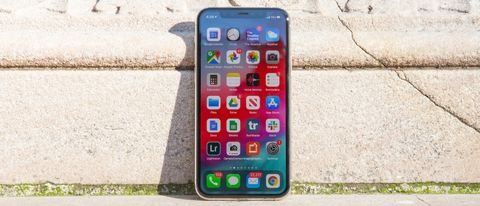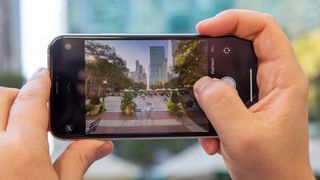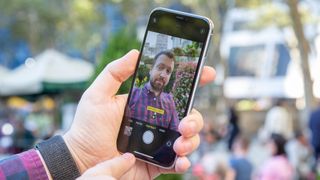iPhone 11 Pro review - The best iPhone you can wrap one hand around

OUR VERDICT
The iPhone 11 Pro is Apple's most powerful phone that come in a one-hand-friendly size. It has a triple-lens camera to capture best-in-class photos and video from a variety of perspectives, a new night mode to enhance low-light photography and extra battery life prowess. Even if the design hasn't changed, this is the camera and battery upgrade iPhone users have been after.
FOR
- Camera a real step forward
- Sizable battery upgrade
- New matte finish on back
AGAINST
- Similar to iPhone XS visually
- Few non-camera upgrades
Two-minute review
The iPhone 11 Pro is Apple's latest iPhone that has people asking us "What's really changed?" It's a fair question because it looks very similar to last year's iPhone. But use the new cameras for a few minutes and both that question and inquisitive looks from doubters quickly fade.
Apple put a lot of effort into its triple-lens rear camera, offering a trio of 12MP lenses that shoot regular, telephoto, and brand new ultra-wide perspectives. Not having to back up to fit everything into the widened frame is a big perk. Also, all of our friends appreciate not having their heads cut off in portrait photos.

'Night Mode', meanwhile, addresses the single biggest complaint we've heard from iPhone users over the years: photos in dimly-lit bars and restaurants don't look very good – not next to their Android phone-touting friends. The shame!
Good news: the iPhone 11 Pro has the best low-light camera we've tested on a phone – any phone. Apple brightens with the best of them and its night mode is automatically applied, topping Samsung, Huawei and Google's interfaces.
Video looks and sounds best-in-class from the oversized rear cameras, yet we found the biggest year-over-year leap in the physically smaller 12MP front camera. It now records in 4K and shoots slo-mo video. Apple's 'Slofies' work best with long, flowing hair to whip back and forth, so we had to get creative in our tests.
So much of the iPhone 11 Pro is about the camera, but there's a bit more. We found battery life noticeably better than the iPhone XS – we've gone longer than a day with heavy use. You don't need the Pro Max for its battery prowess. Its matte finish back cover looks nicer and feels less slippery, though it won't wow as much if you immediately stick an iPhone 11 Pro case on it (which we do recommend).
The 5.8-inch iPhone 11 Pro is the one to get if you want the most advanced iPhone that's easy to use with one hand. It feels a lot smaller than the 6.5-inch iPhone 11 Pro Max and 6.1-inch iPhone 11. Don't be fooled by its size, though, it's pricier than the telephoto-and-OLED-lacking entry-level iPhone 11.
It doesn't look different from past iPhones on the front, so it may seem hard to justify the price. But if you've been waiting for better photos and video out of a new iPhone, this is it – and that's more important than a new look or 5G, at least in 2019.
- Also check out our iPhone 11 review
- Super-size me: here's our iPhone 11 Pro Max review
- The iPhone 11 Pro runs Apple's new iOS 13 software

iPhone 11 Pro release date and price
- iPhone 11 Pro release date was September 20, 2019
- iPhone 11 Pro price started at $999 / £1,049 / AU$1,749
The iPhone 11 Pro was announced on September 12 2019 and the official release date was later that month on September 20. It sells for Pro-level pricing, although in most regions, you're going to pay the same amount as you did for the iPhone XS and iPhone X.
It costs $999 (£1,049, AU$1,749) at launch for the iPhone 11 Pro 64GB version. That's not enough storage for most people with a decade worth of iPhone photos and video, even with iCloud to offload some files. And there's no 128GB option, sadly.
You may instead pay $1,149 (£1,119, AU$1,999) for the 256GB version, the ideal size for most iPhone 11 Pro shoppers, or go all-in for the 512GB size at $1,349 (£1,399, AU$2,349). There's no expandable storage here, like all iPhones before this one, meaning you'll get better storage-for-price value from top Android phones.
You'll also get Apple TV Plus for a year when you buy the new handset, and you may be able to find more appropriate deals for you through carriers and networks using the links below.

Triple-lens camera versatility
Welcome to what's basically the iPhone 11 Pro camera review – we're going to talk a lot about the four cameras and show you plenty of photos from each lens.
Its rear camera trifecta offers wide, 2x optically zoomed and all-encompassing ultra-wide perspectives, the latter being a first for the iPhone. We found the iPhone 11 Pro cameras tout incredible versatility – even in our own daily tech reporter lives.
We were able to zoom in on Apple CEO Tim Cook and the first iPhone 11 customer at the 5th Avenue store re-opening in New York City with the telephoto lens, and then immediately punch out to take in the surrounding celebratory crowd.
Night mode shines
Night mode is the single-greatest reason to upgrade to the iPhone 11 series if you're into photography after dark. It's baked into Apple's main photo mode, not a separate mode like we see on Android rivals, and that makes the feature wholly more useful.
The automatically applied long-exposure settings usually land between 2-5 seconds depending on how dark things are. It can dial up the exposure length to 30 seconds if your iPhone is on a tripod or resting against a wall. A blank night sky can become visible with stars with this mode.
The iPhone 11 Pro night mode is like turning on the lights in the middle of the night, with two caveats. It only works on the main 12MP camera, not the telephoto, ultra-wide or front camera, and subjects can't be moving rapidly. It works well for posing at a dimly-lit bar, but not when trying to capture sick dance moves at a wedding.

Front camera and video
It's fascinating to see how far along HDR has progressed when you snap a photo with the front-facing iPhone 11 Pro camera. It's 12MP (up from 7MP) and packs in a lot of detail. It could be brighter and we felt the need to tone down the warm colors at times when editing our pictures, but overall, this is an impressive upgrade.
Both front and back cameras record 4K video at 60fps (we've been waiting for 4K on the front camera for some time) and slo-mo video has finally come to the selfie cam. No, 'Slofies' wont change your life and they're not actually called that in the UI. But we did have some fun testing the feature at 120fps in 1080p. Know that you can get much slower 240fps 1080p video out of the main camera, though.
More important than frames per second are the two unsung heroes that make video look and sound good: Apple's cinematic video stabilization keeps everything smooth while Audio Zoom hones in the voices or sounds of distant subjects as you zoom in, not things in the periphery. We found it to be better than the Samsung Galaxy Note 10 zoom-in mic feature.
Redesigned camera app – good and bad
The good
Apple redesigned its iPhone camera app, surfacing options to take photos in the 16:9 aspect ratio along with 4:3 (normal) and square (formerly a dedicated mode you'd always accidentally find yourself in). This has made capturing photos for TechRadar in the 16:9 format infinitely easier without the need to crop in post. Great start.
You can hold the shutter button from photo mode to quickly record a video (similar to Instagram and Snapchat interfaces), which makes transitioning between capturing photos and videos with one-hand a piece of cake. You can still take burst shots by sliding the shutter button to the left or keep recording video by sliding it right.
All iOS 13 devices have better editing tools across photos and videos, offering control sliders for sharpness, noise reduction, definition and tint. Best of all, Live Photos will remain intact after your edits, giving you one less reason to open Adobe Lightroom.
The not-as-good
Here's what we didn't like: the most obvious night mode button is at the top of the app with a fluctuating number visible, denoting long exposure time for current lightning conditions. Tap it and an intensity slider shows up along the bottom to change the exposure time. It requires enough thumb exercises that you'll be thankfully to have the smaller iPhone 11 Pro. There is a night mode button along the bottom – sometimes. It's only there when the options menu is displayed.
Apple's minimalist camera app design means you're going to have to toggle between modes and options along the bottom of the app with a swipe up or down on the screen. It's unintuitive because you can only go one way: swipe down to display modes, and up for options. There's a tiny arrow at the top of the screen to hint at which way to swipe, but it's not very obvious.
We're also missing ease-of-use features we love on Android phones:
- Being able to trigger a selfie photo with an open-hand gesture.
- Double tapping the sleep/wake button to quickly boot up the camera. Here it's a shortcut to Apple Pay and we routinely miss fleeting photos ops because of it.
- Flipping between the front and back cameras with a carefree swipe up or down. This essentially treats the screen as a big button you can swipe instead of tucking a camera flip button into the bottom-right corner and requiring a precision press.
- Even with some options surfaced in the app, you can't change from 4K video to 1080p or 30fps to 60fps without exiting the camera app and diving several menus deep into the system-wide Settings menu. Why?
There's more good to come, though. Apple's most recent software update brought a 'Deep Fusion' feature that takes nine exposures and fuses them into a single image after a bunch of machine learning and pixel-by-pixel processing.
We'll update our iPhone 11 Pro review when we've had the opportunity to test this feature properly,
